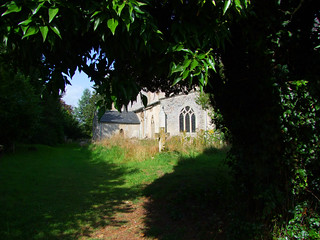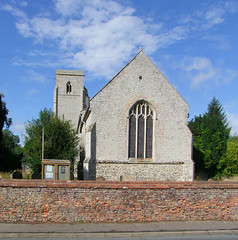| |
|
St Peter,
Hockwold
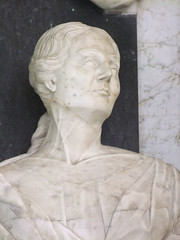 |
|
Hockwold
merges into Wilton in this corner of the
Brecklands. We are close to the Suffolk border
here, and not so very far away from the
Cambridgeshire border. We are also not so very
far from the fen edge, so stone was a possibility
in the late medieval period. They used to bring
it by barge across the undrained fen from the
quarries beyond Peterborough. But what would be
the point? For we are at the centre of the
medieval flint industry. Lakenheath
railway station, on the Norwich to Cambridge
line, sits just to the south of the village, but
unfortunately it now only operates a
'parliamentary service' of two trains a week.
Wilton's church now serves both villages in the
joint parish, and St Peter is in the care of the
Churches Conservation Trust. It is open daily,
although it wasn't on the occasion of my first
visit, a day of heavy rain in the Autumn of 2009.
I pottered about the dripping graveyard with its
pleasing array of late 18th and 19th Century
headstones, and knew I would have to come back
soon.
Seven
years passed, but in the hot summer of 2016 I
came back to Hockwold. It was a day of rising
heat, the precursor to the hottest days of the
year which were to immediately follow. And this
time, the church was open. At first sight, St
Peter is slightly odd, because although this is a
big late medieval church with a south aisle and a
clerestory, the older tower is offset at the west
end of the aisle. This, then, was the site of the
original church.
|
But there
is more to it than this, for, as Pevsner notes, there was
a bequest as late as 1533 for 'hallowing' the church.
This date seems to fit the wonderful angel roof, which is
spectacularly late - another 14 years, and such imagery
would be quite illegal. Is it coincidence that the angels
are already morphing into more secular figures?
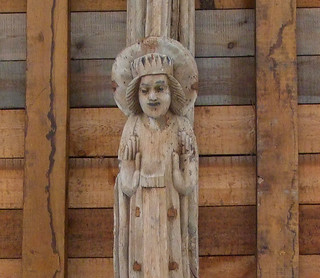 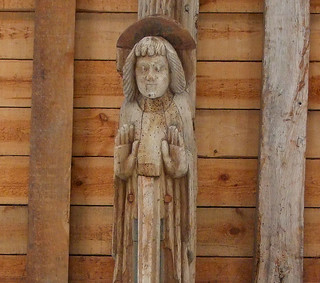
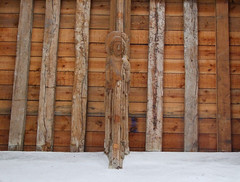 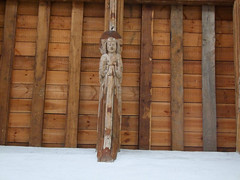 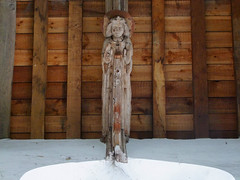
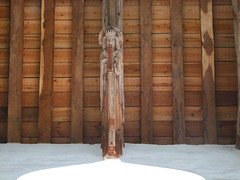 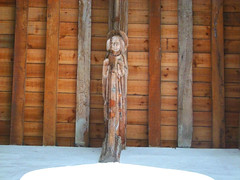 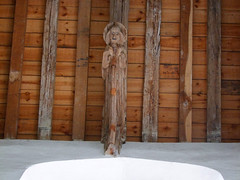
There is
no north aisle or clerestory, but the great windows of
the north side fill the church with light. Above the
north door is a patchwork of late-medieval painted
patternwork.
| Stepping
into the chancel, the east window is filled with
Clayton & Bell's glass depicting the
Crucifixion, flanked by the Resurrection and the
Ascension. Below, Christ enters Jerusalem, prays
at Gethsemane and carries his cross. Well, I
don't know. Does it really enhance this place? I
don't think I've ever seen a Clayton & Bell
window to set the pulses racing, have you? In
their early days they could be good -
witness the excellent work at East Winch, not so
very far from here. But you feel that sometimes a
spiritual space cries out for more than a mere
safe pair of hands. And I am
afraid that both Pevsner and Mortlock moaned
about the memorials that flank it. To the right,
sober and serious busts of 1719 to John and Maria
Hungerford sit awkwardly, shouldering for space
in the frame. There are musical instruments above
them. To the left, an unconvincing cherub for
Cyril Wyche of 1780 holding a wreath, having
leant his upturned torch against the wall. Me, I
can take or leave 18th Century memorials, but
they matter to Pevsner and Mortlock.
Both try to be kind. Neither of the monuments
has the mark of quality, though they do try, argues
Mortlock. Badly carved, which is unlike
Singleton (the carver) says Pevsner.
Mortlock decides that Cyril Wyche's cherub is sadly
overweight.
Oh
dear! Best turn back to the nave, and that
utterly wonderful roof.
|
|
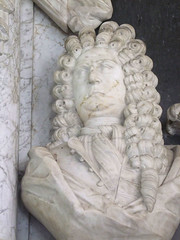 |
|
|
|

